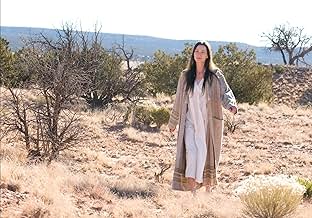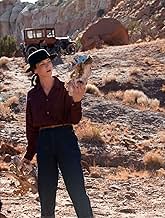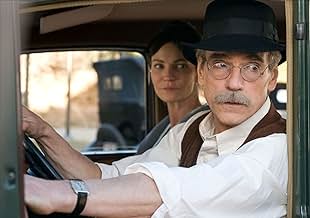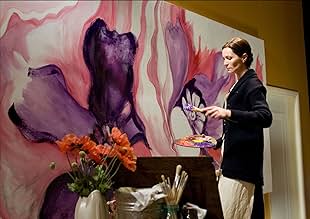Biopic of American artist Georgia O'Keeffe and her husband, photographer Alfred Stieglitz.Biopic of American artist Georgia O'Keeffe and her husband, photographer Alfred Stieglitz.Biopic of American artist Georgia O'Keeffe and her husband, photographer Alfred Stieglitz.
- Nominated for 9 Primetime Emmys
- 1 win & 28 nominations total
- Director
- Writer
- All cast & crew
- Production, box office & more at IMDbPro
Storyline
Did you know
- TriviaThe real inspiration behind this film was the result of producers Joshua D. Maurer and Alixandre Witlin's first visit to the Georgia O'Keeffe Museum in Santa Fe, New Mexico in March, 2006 when they took their eldest daughter Sofia (then almost two years old) to see the collection. Maurer and WiltIn were visiting Sofia's grandparents in Santa Fe and it was her grandmother who made the suggestion that her first museum should be that of famed artists Georgia O'Keeffe. Sofia was so enthralled by the images and so captivated by what she saw, that it gave Maurer and Witlin the idea that to try to portray O'Keeffe's life as a film. As they were leaving the museum, Maurer pitched the idea to Witlin, who is also his producing partner and she agreed but felt the casting of Georgia had to be perfect otherwise it would not work. She asked Josh who he felt would be the ideal casting and Maurer immediately said - "Joan Allen" - and Alix agreed it was a perfect choice. Next Witlin asked him who would buy for development such a film and Maurer immediately responded back - HBO. Witlin agreed. As the Maurer, Witlin and Sofia were leaving the museum, right outside the front door... Maurer immediately called Joan Allen and pitched her the story as Josh and Joan had previously worked closely together on another film project for HBO that unfortunately did not go forward and were looking for another vehicle to collaborate. Joan listened carefully and reported back she loved the idea. Josh told her to hold a beat. He then immediately called Kerri Putnam at HBO and pitched her the idea with Joan attached to star and produce and HBO said yes on the spot. They informed Maurer that this story had been previously pitched over two dozen times but it never felt right to them both in terms of the creative approach by the producers and the casting - but this time it felt perfect. Maurer and Witlin, holding Sofia in their arms, then called Joan back and told her the positive news. Thus began an intensive and passionate development process with HBO and writer Michael Cristofer that resulted in a brilliant screenplay. Maurer, Witlin and Allen visited Santa Fe a few times to do extensive research and took Sofia with them. HBO then had had the project greenlit but when HBO president Colin Callender left the company the project was unfortunately put in turnaround. Disappointed but not defeated, 45 minutes later, Maurer reached out directly to Lifetime Television and sold the project to them in turnaround and then brought on Sony Pictures Television as their deficit financing partner. When the film was officially screened in Santa Fe... Joan Allen spoke and asked Sofia (now aged 4) to stand up and take a bow and the entire audience gave her a standing ovation.
- GoofsPart of this movie was filmed at Ghost Ranch in New Mexico. When Georgia walks out of the house in the morning she is barefoot. This would never happen in real life due to scorpions, fire ants, Cholla cactus thorns, tumbleweed thorns, and a plant called goat's-head weed. This plant has woody thorns that give the plant its nickname of puncturevine.
- ConnectionsFeatured in The 62nd Primetime Emmy Awards (2010)
Featured review
About a year ago, when the cast was announced for this film, much flurry was made about Henry Simmons playing the role of writer Jean Toomer, the third point in the crucial triangle that really led Georgia O'Keeffe to decide to stay away from Stieglitz.
Imagine the unexpected disappointment when in the broadcast film, Simmons as Toomer was stifled to not a single honest line of dialog! He is reduced to mention in an insane and inaccurate tirade by Stieglitz as "the Black Prince of Harlem" many decades before Malcolm X (to whom the epithet rightly belongs) was born. And these lines sound quite unworthy of a writer the caliber of Cristofer.
Not only was Toomer, a man of mixed race, hardly in Harlem, but he spent most of his life fighting against being classified as a "Negro writer." Then, even more surprisingly, scenes between O'Keeffe and Toomer show up on the Lifetime website and comprise the great majority of what was omitted from the final presentation -- scenes that could shed quite a different light on her choices about remaining in New Mexico.
Obviously, some effort was made to make Joan Allen and Jeremy Irons look like their historical subjects. Simmons does not look like Toomer at all. At least in the old American Playhouse version of the story Vernal Bagneris makes a credible representative.
Moreover, the finished quality of the omitted scenes belies a late cut. It would certainly be interesting to learn something more for the production record, even if not to abate the unanimous canning by the critics. Toomer's disappearing act is one of the major reasons the film failed.
Imagine the unexpected disappointment when in the broadcast film, Simmons as Toomer was stifled to not a single honest line of dialog! He is reduced to mention in an insane and inaccurate tirade by Stieglitz as "the Black Prince of Harlem" many decades before Malcolm X (to whom the epithet rightly belongs) was born. And these lines sound quite unworthy of a writer the caliber of Cristofer.
Not only was Toomer, a man of mixed race, hardly in Harlem, but he spent most of his life fighting against being classified as a "Negro writer." Then, even more surprisingly, scenes between O'Keeffe and Toomer show up on the Lifetime website and comprise the great majority of what was omitted from the final presentation -- scenes that could shed quite a different light on her choices about remaining in New Mexico.
Obviously, some effort was made to make Joan Allen and Jeremy Irons look like their historical subjects. Simmons does not look like Toomer at all. At least in the old American Playhouse version of the story Vernal Bagneris makes a credible representative.
Moreover, the finished quality of the omitted scenes belies a late cut. It would certainly be interesting to learn something more for the production record, even if not to abate the unanimous canning by the critics. Toomer's disappearing act is one of the major reasons the film failed.
- bricoleur9
- Sep 25, 2009
- Permalink
Details
- Runtime1 hour 29 minutes
- Color
- Sound mix
- Aspect ratio
- 1.78 : 1
Contribute to this page
Suggest an edit or add missing content




































